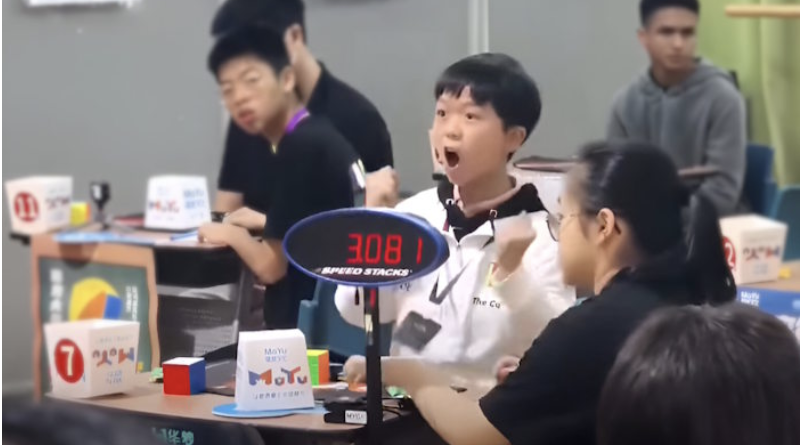On February 16, 2025, Chinese speedcuber Yiheng Wang completed an official WCA 3x3x3 solve in 3.08 seconds, beating the previous world record held by Californian speedcuber Max Park by 0.05 seconds (Park’s record occurred back in 2023).
Now, to the average person, this seems like a nearly impossible accomplishment that requires inhuman levels of skill…To speedcubers, this is still a nearly impossible accomplishment that requires inhuman levels of skill, but cubers may see the feat with a bit more nuance and understanding of how it occurred.
- TPS
TPS stands for “turns per second” and of course refers to the amount of turns done on a speed cube for every one second. There are many factors that go into an individual’s TPS on a given solve but they all essentially boil down to two things: hardware and finger speed. Yiheng Wang is formerly sponsored by GANCUBE, a top speed cube brand known for manufacturing high quality yet expensive speedcubes. GANCUBE is most well known for their 3x3s. However, being sponsored by GANCUBE means that you are only allowed to use their cubes in official competitions. Yiheng Wang recently ended his sponsorship with GANCUBE, opting for Moyu cubes instead. This is somewhat interesting considering GANCUBE used to have a reputation for having the best 3x3s on the market, but it is not that surprising as Moyu has been producing high quality cubes for several years. What is more interesting is the ‘fingerspeed’ itself. Yiheng Wang achieved 14.61 TPS on this solve. 8 years ago, former world record holder and cubing legend Feliks Zemdegs said that the human peak average TPS was likely 11-12 TPS. This is because turn speed is hindered by the novelty of combinations needed to complete different solves. There are over 43 quintillion possible scrambles on a 3x3x3 rubik’s cube. Pro cubers who drill their algorithms can often reach TPS much higher than 14.61 when practicing the same algorithm over and over again, but reaching an average TPS this high, especially in an official solve where competition nerves are at play, is truly an accomplishment. The raw finger speed itself is achieved through years of practice, but closing that ‘gap’ where you need to both turn fast and figure out what the correct turns to do are split into three skills: inspection, lookahead, and recognition. Inspection refers to the 15 seconds you are given to inspect the cube before solving during official competitions. Pro cubers can (on average) see the cross and one or two F2L pairs during inspection (this makes up a bit less than half the entire solve). Lookahead is the ability to see one step while executing another. You do not need to be actively thinking while you are turning so you save time by calculating your next moves while you are completing your last. Recognition is the ability to recognize patterns on the puzzle and is a skill that mostly comes naturally through practice.
- Method
CFOP is the most popular 3×3 method and is the main method used by every cuber in the top 10. CFOP stands for Cross, F2L, OLL, and PLL. Cross is when you solve 4 edge pieces of the cube into a cross shape, F2L is when you solve the first 2 layers, OLL is when you orient the last layer by solving the color of the top face, and PLL is a permutation of the last layer that completes the solve. Yiheng Wang’s F2L was not done in a traditional CFOP style for his world record solve, he used block building techniques that by definition make the world record solve a ZZ solve. ZZ is a less common speedcubing method which involves orienting edges and then solving them in blocks, then using algorithms to complete the last layer. It is worth noting that this absolutely does not mean that ZZ is a better method than CFOP. The traditional cross to F2L in CFOP is often slower than cross to F2L with a bit of creative ZZ-style block building. The fact that no CFOP-style F2L was used in the first 2 layers of the world record solve is a bit of a coincidence, as a slightly different scramble might’ve called for a CFOP-style F2L technique.
- Luck
There are some scrambles that you just can’t get a world record on. The scramble for Yiheng Wang’s 3.08 was objectively a good scramble, despite the crazy amount of practice, talent, and skill that went into the solve.
Misconceptions
Many non-cubers (despite how it sounds this is a non-derogatory term), upon hearing world record news, may have false beliefs on how it occurred.
- The entire solution is not calculated in inspection
There is currently no human on earth who can consistently see the entire solution to a scramble in inspection. Pros tend to see around half the solution (Cross + several F2L pairs) in inspection, and nerves and mental blockage from being in a stressful competition setting may cause them to see even less.
- The solution itself wasn’t “perfect”
It has been proven that any rubik’s cube scramble can be solved in 20 moves or less (which is why 20 is nicknamed “god’s number”). The best times achieved in speedcubing are not done using these theoretically perfect solutions. Yiheng Wang’s 3.08 world record was achieved using a 45 move solution and past world records were achieved using solutions slightly over 30 moves. There are several reasons behind this but a fundamental one (which corrects a misconception that even some speedcubers have) is that low move count does not necessarily mean faster times. This is because human solves are restricted by human hands. A minimum move count solution may be trickier to execute than a longer solution with moves that are easier to execute fluidly due to the way our hands are structured.
- The official world record is not the best a human has ever achieved
The world record is the fastest time ever achieved in an official WCA (world cube association) competition. Several pro speedcubers in the top 100 have achieved unofficial sub 3 solves at home, and pretty much every speedcuber ever has a higher official record than at home record. The reason why there is a gap between official records and unofficial records is because of luck and nerves; nerves in competition are much more of a bigger deal than one might think, especially in a sport that relies on the mind as much as cubing, it is often harder to see good solutions in competition than in a relaxed setting at home, and having bad nerves can make your hands stiff and hinder your TPS. Additionally, at most competitions you are usually only able to do five solves at a time for each round, and most competitions have 2-3 rounds for 3×3. This is not very many chances to get lucky getting a good scramble, seeing a good solution, or achieving a high fluid TPS.
- Your cousin is not faster than Yiheng Wang
This is a bit of a tangent but there is a stereotype that when you talk about times to a non-cuber they will claim that their cousin (or someone they know distantly) is able to solve a cube in an even smaller amount of time. Unless they are related to/know a very dedicated pro speedcuber this is probably not the case. There are many reasons why they may think they have evidence of someone being faster than pro cubers, including illegitimate scrambles, rehearing a solution to a specific scramble ahead of time, or even outright faking video evidence. Bottom line, if the person you know cannot achieve ~4-7 second solves on any scramble on average, there is no way they have a personal best that is better than the world record.







